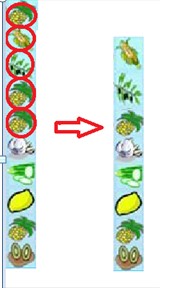LianLianKan
Time Limit: 2000/1000 MS (Java/Others) Memory Limit: 32768/32768 K (Java/Others)
Total Submission(s): 3681 Accepted Submission(s): 1101
Problem Description
I like playing game with my friend, although sometimes looks pretty naive. Today I invent a new game called LianLianKan. The game is about playing on a number stack.
Now we have a number stack, and we should link and pop the same element pairs from top to bottom. Each time, you can just link the top element with one same-value element. After pop them from stack, all left elements will fall down. Although the game seems to be interesting, it's really naive indeed.

To prove I am a wisdom among my friend, I add an additional rule to the game: for each top element, it can just link with the same-value element whose distance is less than 6 with it.
Before the game, I want to check whether I have a solution to pop all elements in the stack.
Now we have a number stack, and we should link and pop the same element pairs from top to bottom. Each time, you can just link the top element with one same-value element. After pop them from stack, all left elements will fall down. Although the game seems to be interesting, it's really naive indeed.

To prove I am a wisdom among my friend, I add an additional rule to the game: for each top element, it can just link with the same-value element whose distance is less than 6 with it.
Before the game, I want to check whether I have a solution to pop all elements in the stack.
Input
There are multiple test cases.
The first line is an integer N indicating the number of elements in the stack initially. (1 <= N <= 1000)
The next line contains N integer ai indicating the elements from bottom to top. (0 <= ai <= 2,000,000,000)
The first line is an integer N indicating the number of elements in the stack initially. (1 <= N <= 1000)
The next line contains N integer ai indicating the elements from bottom to top. (0 <= ai <= 2,000,000,000)
Output
For each test case, output “1” if I can pop all elements; otherwise output “0”.
Sample Input
2
1 1
3
1 1 1
2
1000000 1
Sample Output
1
0
0
http://acm.hdu.edu.cn/showproblem.php?pid=4272
题意:
题意:长度为n(n<=1000)的栈,栈顶元素可以与下面1~5个数中相同的元素消去,问最后能都完全消去。
题解:
状态压缩 dp 如何判断一个 物品 是否可以 被删除 ,首先 最坏的 情况是 2 0 0 0 0 1 1 1 1 2 假如我们要消除 栈顶的 2 ,0表示已经被删除了。
辅助解释:假设2前面有一个3,那么3能够消除的最远位置为最后一个0处;
我们要 知道 包括 本身在内的 10 个 数位
定义dp[h][i]表示高度为h,状态为i时能否全部消除; 二进制位1表示未消除,0表示当前位已消除;
/**定义dp[h][i]表示高度为h,状态为i时能否全部消除; 二进制位1表示未消除,0表示当前位已消除;*/#include<iostream>#include<cstring>#include<cstdio>#include<string>#include<set>#include<algorithm>#include<vector>#include<map>#include<queue>#include<cmath>#include<cctype>#include<stack>#include<iomanip>using namespace std;const int maxn = 1200;int dp[maxn][maxn];int a[maxn];int dfs(int h,int c){ if(h < 0){ if(c) return 0;// else return 1;// 结果为0,表明可以完全消除; } if(dp[h][c]!=-1) return dp[h][c]; int &res = dp[h][c]; res = 0; int t = c&(1<<9);//获得定点的位,以判断是否已经被消除; if(t){//未被消除; c = c^(1<<9);//把顶去掉; int cnt = 0; for(int i = 1,j = 8;i <= 9&&j>=0; i++,j--){ if(c&(1<<j)){//如果当前位置未去掉; cnt++; if(cnt>5) break;//控制距离小于6; if(a[h] == a[h-i]){//如果和顶相等;去掉当前位; int t = c^(1<<j); t <<= 1; if(h-10>=0) t += 1; res = dfs(h-1,t); // else res = dfs(h-1,t); if(res) break; } } } }else {//已经被消除时,脱栈顶; c <<= 1; if(h-10>=0) res = dfs(h-1,c+1);//h>=10表明可以继续下移; else res = dfs(h-1,c); } return res;}int main(){ int n; while(scanf("%d",&n)==1) { for(int i = 0; i < n; i++){ scanf("%d",&a[i]); } if(n%2){//数量为奇数个,肯定不可以一一配对完全消除; printf("0
"); continue; } memset(dp,-1,sizeof dp); int c = 0, i, j; for(i = n-1, j = 0; i >= 0&&j<=9; i--,j++){//初始化二进制111111111; c = (c<<1)+1; } while(j<=9){//n<9时,补0;只是为了方便同一处理; c <<= 1; j++; } printf("%d
",dfs(n-1,c)); } return 0;}